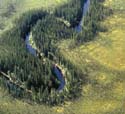
River in Alaska bordered by P. glauca forests surrounded by muskeg containing scattered small P. mariana [Dr. Linda B. Brubaker].
Common Names
White spruce, Canada spruce, skunk spruce, cat spruce, single spruce (2, 3), western white spruce (var. albertiana , Canadian Rocky Mts), Porsild spruce (var. porsildii , Alaska), Black Hills spruce (var. densata , Dakota), épinette blanche (Canadian French) (5).
Taxonomic notes
Syn: Pinus glauca Moench 1785; Abies canadensis Miller; Picea alba (Aiton) Link; P. alba var. albertiana (S. Brown) Beissner; P. albertiana S. Brown; P. canadensis (Miller) Britton, Sterns, & Poggenburg; P. canadensis var. glauca (Moench) Sudworth; P. glauca var. albertiana (S. Brown) Sargent; P. glauca var. densata Bailey; P. glauca var. porsildii Raup; Pinus alba Aiton (5)."In areas of sympatry P. glauca and P. engelmannii regularly hybridize and intergrade completely (Daubenmire 1974; Garman 1957; Horton 1959; Roche 1969; Taylor 1959). This has greatly complicated the taxonomy of P. glauca . Three varieties have been recognized. P. glauca var. albertiana was described as having unusually prominent leaf bases, cones nearly as broad as long, cone scales acute and broader than long, and an unusually narrow crown. These are common characteristics of hybrids (e.g., Daubenmire 1974). P. glauca var. porsildii was described as differing from the type variety by having smooth bark with resin blisters, short angular cone scales, an unusually broad crown, and pubescent twigs. These characteristics, also largely intermediate between those of P. glauca var. glauca and P. engelmannii , may reflect hybridization where the species overlap. Although the two varieties noted above are reported from well beyond the range of sympatry, the diagnostic characteristics are not well correlated and occur rather sporadically. Also the most distinctive feature of the varieties, the crown shape, is in part responsive to competitive pressures. Because of the problems of hybridization and sporadic occurrence of key characters, P. glauca is treated here in the broad sense" (5).
Description
Trees to 50 m tall and 100 cm dbh (8);"crown broadly conic to spirelike. Bark gray-brown. Branches slightly drooping; twigs not pendent, rather slender, pinkish brown, glabrous. Buds orange-brown, 3-6 mm, apex rounded. Leaves (0.8)1.5-2(2.5) cm, 4-angled in cross section, rigid, blue-green, bearing stomates on all surfaces, apex sharp-pointed." Seed cones green or violet ripening pale buff, cylindric, soft,"2.5-6(8) cm; scales fan-shaped, broadest near rounded apex, 10-16 × 9-13 mm, flexuous, margin at apex ± entire, apex extending 0.5-3 mm beyond seed-wing impression. 2 n =24" (5).In var. albertiana , the shoots are pubescent and the leaves slightly longer (1.5-2 cm, vs. 0.8-1.3 cm for the type) (8).
Range
Canada: Yukon, North West Territories, British Columbia, Alberta, Saskatchewan, Manitoba, Ontario, Québec, Prince Edward Island, New Brunswick, Nova Scotia, Newfoundland; France: St. Pierre and Miquelon; USA: Alaska, Montana, Wyoming, South Dakota, Minnesota, Wisconsin, Michigan, New York, Vermont, New Hampshire, Maine; at 0-1000 m,"between 5-1900 m (var. albertiana up to 2100 m)." (8). See also (10). In habitats ranging from muskegs, bogs, and river banks to montane slopes (5). It is a dominant tree of interior forests over vast expanses of Canada and Alaska. USDA hardiness zone 2. Where accepted, the varieties are distributed: var. albertiana in the Canadian Rocky Mts., var. porsildii in Alaska, and var. densata in South Dakota.The photograph illustrates characteristic habitat partitioning between P. glauca and P. mariana . The two species co-occur over a wide range and have evolved a very complex competitive relationship involving contrasts in tolerance of mesic sites, capacity to reproduce vegetatively, timing of reproductive phenology, rate of seedling and sapling growth, and some other factors. In general, though, P. glauca enjoys a competitive advantage on well-drained mineral soils with deep or no permafrost, such as the alluvial levees along the stream in the photograph, while P. mariana is more tolerant of adverse site conditions including flooding, permafrost and high soil acidity, all of which occur in the muskeg (9).
Big Tree
Height 40 m, dbh 101 cm, crown spread 9 m, located in Koochiching County, MN (6).Oldest
A crossdated age of 522 years for a specimen from Norton Bay, AK collected by Giddings in 1951 (7). I believe this is from a stump; Giddings did a lot of chainsaw sampling.Dendrochronology
Ethnobotany
Observations
Remarks
White spruce is the provincial tree of Manitoba and Black Hills spruce the state tree of South Dakota (5).Citations
(1) Silba 1986 .(2) Elias 1987.
(3) Peattie 1950.
(5) Ronald J. Taylor at the Flora of North America web site.
(7) Brown 1996.
(8) Farjon 1990.
(9) Deborah Elliott-Fisk. 1988. The boreal forest. Pp. 31-62 in M.G. Barbour
and W.D. Billings, eds., North American Terrestrial Vegetation.
Cambridge: Cambridge University Press.
(10) Robert S. Thompson, Katherine H. Anderson and Patrick J. Bartlein. 1999. Atlas of Relations Between Climatic Parameters and Distributions of Important Trees and Shrubs in North America. U.S. Geological Survey Professional Paper 1650 A&B. URL= http://greenwood.cr.usgs.gov/pub/ppapers/p1650-a/pages/conifers.html, accessed 22-Jan-2000.
See also:
Burns & Honkala 1990.
FEIS database.
Little 1980.
Little & Pauley 1958.
LaRoi, G.H. and J.R. Dugle. 1968. A systematic and genecological study of
Picea glauca and P. engelmannii, using paper chromatography of needle extracts.
Canadian Journal of Botany 46:649-687.
This page co-edited with Michael P. Frankis, Dec-1998.
[ Picea ] [ Pinaceae ] [ home ]
This page is from the Gymnosperm Database
URL: http://www.geocities.com/~earlecj/pi/pic/glauca.htm
Edited by Christopher J. Earle
E-mail:
earlecj@earthlink.com
Last modified on 24-Jan-2000